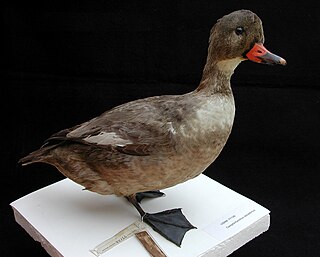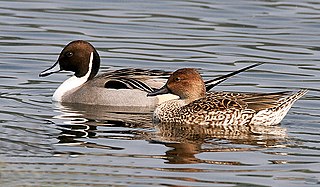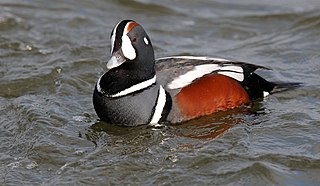
The Labrador duck is an extinct North American duck. It has the distinction of being the first known endemic North American bird species to become extinct after the Columbian Exchange, with the last known sighting occurring in 1878 in Elmira, New York. It was already a rare duck before European settlers arrived, and as a result of its rarity, information on the Labrador duck is not abundant, although some, such as its habitat, characteristics, dietary habits and reasons behind its extinction, are known. There are 55 specimens of the Labrador duck preserved in museum collections worldwide.

Duck is the common name for numerous species of waterfowl in the family Anatidae. Ducks are generally smaller and shorter-necked than swans and geese, which are members of the same family. Divided among several subfamilies, they are a form taxon; they do not represent a monophyletic group, since swans and geese are not considered ducks. Ducks are mostly aquatic birds, and may be found in both fresh water and sea water.

The Anatidae are the biological family of water birds that includes ducks, geese, and swans. The family has a cosmopolitan distribution, occurring on all the world's continents except Antarctica. These birds are adapted for swimming, floating on the water surface, and in some cases diving in at least shallow water. The family contains around 174 species in 43 genera.

The Oxyurini are a tribe of the duck subfamily of birds, the Anatinae. It has been subject of considerable debate about its validity and circumscription. Some taxonomic authorities place the group in its own subfamily, the Oxyurinae. Most of its members have long, stiff tail feathers which are erected when the bird is at rest, and relatively large, swollen bills. Though their relationships are still enigmatic, they appear to be closer to swans and true geese than to the typical ducks. The highest diversity is found in the warmer parts of the Americas, but at least one species occurs in a major part of the world.

The smew is a species of duck and is the only living member of the genus Mergellus. Mergellus is a diminutive of Mergus and albellus is from Latin albus "white". This genus is closely related to Mergus and is sometimes included in it, though it might be closer to the goldeneyes (Bucephala). The smew has hybridized with the common goldeneye.

The diving ducks, commonly called pochards or scaups, are a category of duck which feed by diving beneath the surface of the water. They are part of Anatidae, the diverse and very large family that includes ducks, geese, and swans.

The Anatinae are a subfamily of the family Anatidae. Its surviving members are the dabbling ducks, which feed mainly at the surface rather than by diving. The other members of the Anatinae are the extinct moa-nalo, a young but highly apomorphic lineage derived from the dabbling ducks.

The pintail or northern pintail is a duck species with wide geographic distribution that breeds in the northern areas of Europe and across the Palearctic and North America. It is migratory and winters south of its breeding range to the equator. Unusually for a bird with such a large range, it has no geographical subspecies if the possibly conspecific duck Eaton's pintail is considered to be a separate species.

The long-tailed duck, formerly known as the oldsquaw, is a medium-sized sea duck that breeds in the tundra and taiga regions of the arctic and winters along the northern coastlines of the Atlantic and Pacific Oceans. It is the only member of the genus Clangula.

The musk duck is a highly aquatic, stiff-tailed duck native to southern Australia. It is the only living member of the genus Biziura. An extinct relative, the New Zealand musk duck or de Lautour's duck, once occurred on New Zealand, but is only known from prehistoric subfossil bones. It was about 8% longer than the living species, with a particularly large head.

The harlequin duck is a small sea duck. It takes its name from Harlequin, a colourfully dressed character in Commedia dell'arte. The species name comes from the Latin word "histrio", meaning "actor". In North America it is also known as lords and ladies. Other names include painted duck, totem pole duck, rock duck, glacier duck, mountain duck, white-eyed diver, squeaker and blue streak.

The ruddy duck is a duck from North America and one of the stiff-tailed ducks. The genus name is derived from Ancient Greek oxus, "sharp", and oura, "tail", and jamaicensis is "from Jamaica".

The lesser scaup is a small North American diving duck that migrates south as far as Central America in winter. It is colloquially known as the little bluebill or broadbill because of its distinctive blue bill. The origin of the name scaup may stem from the bird's preference for feeding on scalp—the Scottish word for clams, oysters, and mussels; however, some credit it to the female's discordant scaup call as the name's source. It is apparently a very close relative of the Holarctic greater scaup or "bluebill", with which it forms a superspecies. The scientific name is derived from Ancient Greek aithuia an unidentified seabird mentioned by authors including Hesychius and Aristotle, and Latin, affinis "related to", from its resemblance to the greater scaup.

The ferruginous duck, also known as ferruginous pochard, common white-eye or white-eyed pochard, is a medium-sized diving duck from Eurosiberia. The scientific name is derived from Greek aithuia an unidentified seabird mentioned by authors including Hesychius and Aristotle, and nyrok, the Russian name for a duck.

The black-headed duck is a South American duck in subfamily Oxyurinae of family Anatidae. It is found in Argentina, Bolivia, Brazil, Chile, Paraguay, and Uruguay.

The fulvous whistling duck or fulvous tree duck is a species of whistling duck that breeds across the world's tropical regions in much of Mexico and South America, the West Indies, the southern United States, sub-Saharan Africa and the Indian subcontinent. It has plumage that is mainly reddish brown, long legs and a long grey bill, and shows a distinctive white band across its black tail in flight. Like other members of its ancient lineage, it has a whistling call which is given in flight or on the ground. Its preferred habitat consists of wetlands with plentiful vegetation, including shallow lakes and paddy fields. The nest, built from plant material and unlined, is placed among dense vegetation or in a tree hole. The typical clutch is around ten whitish eggs. The breeding adults, which pair for life, take turns to incubate, and the eggs hatch in 24–29 days. The downy grey ducklings leave the nest within a day or so of hatching, but the parents continue to protect them until they fledge around nine weeks later.

The Madagascar pochard or Madagascan pochard is an extremely rare diving duck of the genus Aythya. Thought to be extinct in the late 1990s, specimens of the species were rediscovered at Lake Matsaborimena near Bemanevika in Madagascar in 2006. By 2017, a captive breeding program had produced a population of around 90 individuals. The birds were reintroduced to the wild in December 2018.

The least grebe, an aquatic bird, is the smallest member of the grebe family. It occurs in the New World from the southwestern United States and Mexico to Argentina, and also on Trinidad and Tobago, the Bahamas and the Greater Antilles.

The Maccoa duck is a stiff-tailed diving duck found across Eastern and Southern Africa.

The Andean duck is a bird species native to the Andean Mountains of South America, one of the stiff-tailed ducks. It was considered a subspecies of the ruddy duck. In fact, some taxonomic authorities still consider it conspecific, including the American Ornithological Society.

























